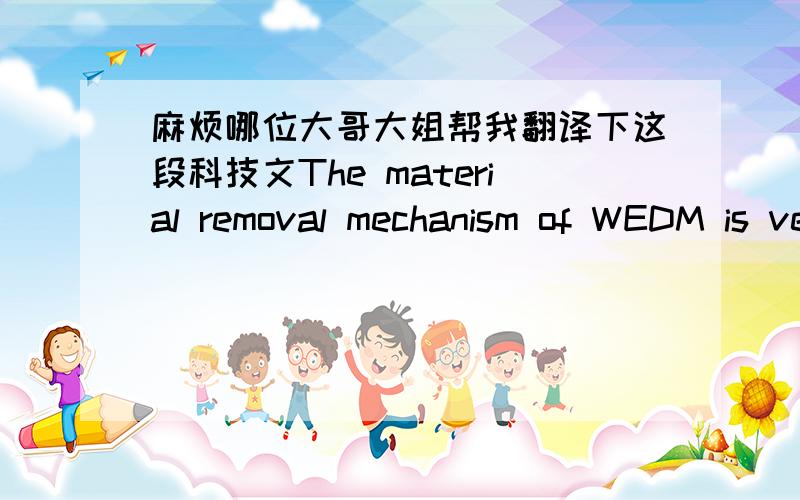麻烦哪位大哥大姐帮我翻译下这段科技文The material removal mechanism of WEDM is very similar to the conventional EDM process involving the erosion effect produced by the electrical discharges (sparks). In WEDM, material is eroded from
来源:学生作业帮助网 编辑:作业帮 时间:2024/11/29 06:36:16

麻烦哪位大哥大姐帮我翻译下这段科技文The material removal mechanism of WEDM is very similar to the conventional EDM process involving the erosion effect produced by the electrical discharges (sparks). In WEDM, material is eroded from
麻烦哪位大哥大姐帮我翻译下这段科技文
The material removal mechanism of WEDM is very similar to the conventional EDM process involving the erosion effect produced by the electrical discharges (sparks). In WEDM, material is eroded from the workpiece by a series of discrete sparks occurring between the workpiece and the wire separated by a streamof dielectric fluid, which is continuously fed to the machining zone [4]. However, today’s WEDM process is commonly conducted on workpieces that are totally submerged in a tank filled with dielectric fluid. Such a submerged method of WEDM promotes temperature stabilisation and efficient flushing especially in cases where the workpiece has varying thickness. The WEDM process makes use of electrical energy generating a channel of plasma between the cathode and anode [5], and turns it into thermal energy [6] at a temperature in the range of 8000–12,000 vC [7] or as high as 20,000 vC [8] initialising a substantial amount of heating and melting of material on the surface of each pole. When the pulsating direct current power supply occurring between 20,000 and 30,000 Hz [9] is turned off, the plasma channel breaks down. This causes a sudden reduction in the temperature allowing the circulating dielectric fluid to implore the plasma channel and flush the molten particles from the pole surfaces in the formof microscopic debris. While the material removal mechanisms of EDM and WEDM are similar, their functional characteristics are not identical. WEDM uses a thin wire continuously feeding through the workpiece by a microprocessor, which enable parts of complex shapes to be machined with exceptional high accuracy. A varying degree of taper ranging from15 v for a 100 mm thick to 30v for a 400 mm thick workpiece can also be obtained on the cut surface. The microprocessor also constantly maintains the gap between the wire and the workpiece, which varies from0.025 to 0.05 mm [2]. WEDM eliminates the need for elaborate pre-shaped electrodes, which are commonly required in EDM to perform the roughing and finishing operations. In the case of WEDM, the wire has to make several machining passes along the profile to be machined to attain the required dimensional accuracy and surface finish (SF) quality. Kunieda and Furudate [10] tested the feasibility of conducting dry WEDM to improve the accuracy of the finishing operations, which was conducted in a gas atmosphere without using dielectric fluid. The typical WEDM cutting rates (CRs) are 300 mm2/min for a 50 mm thick D2 tool steel and 750 mm2/min for a 150 mm thick aluminium [11], and SF quality is as fine as 0.04–0.25 lRa. In addition, WEDM uses deionised water instead of hydrocarbon oil as the dielectric fluid and contains it within the sparking zone. The deionised water is not suitable for conventional EDM as it causes rapid electrode wear, but its low viscosity and rapid cooling rate make it ideal for WEDM [12].
不要GOOGLE的答案
麻烦哪位大哥大姐帮我翻译下这段科技文The material removal mechanism of WEDM is very similar to the conventional EDM process involving the erosion effect produced by the electrical discharges (sparks). In WEDM, material is eroded from
对传统的 EDM 包括被电的解除 (火花) 生产的腐蚀效果的程序 WEDM 的物质移动机制非常相似.在 WEDM 中,材料从细工品被在细工品和被 streamof 电介体液体分开的电线之间发生的一系列不连续的火花侵蚀,这不断地被喂到机制地域 [4].然而,今天的 WEDM 程序普遍在完全地在一个充满诱电性的液体战车中被浸水的细工品上被引导.如此的一个 WEDM 的水平面下方法在细工品有改变厚度的情形中尤其促进温度安定和有效率的脸发红.WEDM 程序利用电的能源产生一个血浆的频道在阴极和阳极之间 [5],而且将它变成热的能源 [6] 在 8000 – 12,000 vC 的范围温度 [7] 或高达 20,000 vC[8] initialising 实质上量的暖气和熔化的在每个杆的表面上的材料.当那搏动直接的现在电源在 20,000 和 30,000 Hz 之间供应发生的时候 [9] 被关掉 ,血浆频道压倒.这引起允许循环诱电性的液体恳求血浆频道而且脸发红来自杆的溶化粒子 formof 显微镜的碎片表面的温度突然的减少.EDM 和 WEDM 的物质移动机制是相似的,不过他们的功能特性不是同一的.WEDM 使用不断逐渐强烈经过一个微处理器的细工品的瘦电线,使复杂形状的部份能够与例外的高准确性一起以机器制造.一个为也为 400 毫米对 30 v 是厚的厚细工品的 100 毫米排列 from15 v 的小腊烛的改变程度能在削减表面上被获得.微处理器也不变地维持在电线和细工品之间的缝隙,改变 from0.025 到 0.05 毫米 [2].WEDM 除去对精细的预先成形电极的需要,普遍是 EDM 所必备者运行那个粗糙而且完成操作.在 WEDM 的情况,电线必须沿着描绘制造一些机制途径被以机器制造达到必需的空间准确性和表面的完成 (SF) 质量.Kunieda 和 Furudate[10] 测试了引导干的 WEDM 改善最后的操作准确性的可行性,这不需要使用电介体液体就在瓦斯大气中被引导.切比率 (CRs) 的典型 WEDM 对于 150 毫米厚的铝是 50 毫米的 300 mm2/ 最小厚的 D2 工具钢和 750 mm2/ 最小 [11],而且 SF 质量像 0.04 –一样的好是 0.25 lRa .除此之外,WEDM 使用除去离子水代替碳化氢如诱电性的液体油并且在闪烁地域里面包含它.那除去离子水当它引起迅速的电极穿着,对传统的 EDM 是不适当的,但是它的低黏质和迅速的冷却比率使 WEDM 的它理想 [12].